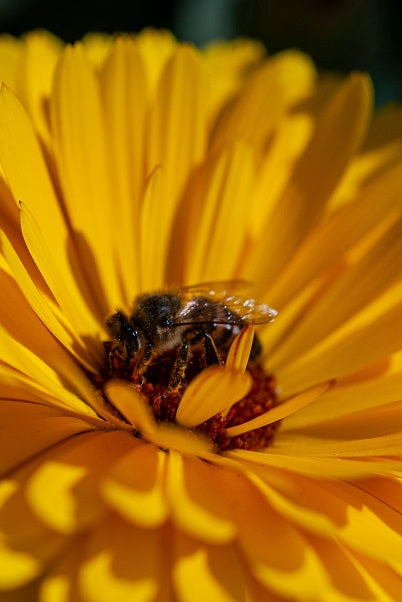
Calendula
Calendula officinalis
The calendula , also known as the marigold, is a versatile plant that has been used for centuries for medicinal and cosmetic purposes. With its powerful compounds and wide applications, calendula remains one of the most beloved herbs for both traditional and modern health care.
In this blog we discuss the origin of the plant, how to grow it at home, its main constituents and their interaction with the human body.
History of calendula
Calendula officinalis, better known as marigold, has a rich history that dates back to ancient times. The plant was already valued by the ancient Egyptians for its rejuvenating properties, while the Romans and Greeks used it for medicinal and cosmetic purposes. In the Middle Ages, calendula was often processed in ointments and teas to treat wounds and reduce inflammation. In addition, the flower had a symbolic meaning; it was associated with the sun and symbolized warmth and joy.
Today, calendula is used worldwide in both traditional and modern medicine for its versatile applications.

How and where does calendula grow?
Calendula officinalis is an annual plant that originates from Southern Europe and the Mediterranean. Today, the plant grows in many parts of the world, especially in temperate climates. It thrives in sunny areas with well-drained, nutritious soil. Calendula is a strong plant that can withstand various weather conditions, which makes it suitable for growing both in the ground and in pots on a balcony. The bright orange or yellow flowers usually bloom from early spring to autumn, depending on the climate and care.
How to grow calendula at home?
Seeds or plants, buy or exchange
You can buy calendula seeds or a young plant from a garden center. Most people choose a plant, because growing from seeds can take some time.
In some villages and towns there are plant swap events or small stands at markets, who knows you can share or swap your creations with others!
Sow calendula seeds in early spring, directly into the ground or in pots. Make sure the soil is loose and well-drained. Cover the seeds with a thin layer of soil and water gently. Within one to two weeks, the first shoots will appear, provided they receive sufficient light and warmth.
Location
Calendula likes a sunny spot, but can also grow in partial shade. Make sure the plant gets at least six hours of sunlight per day for optimal flowering. Although the plant is not demanding, it grows best in fertile, slightly moist soil with good drainage. Over-fertilization can lead to fewer flowers and more foliage, so use organic compost instead of chemical fertilizers.
Water and maintenance
Calendula needs regular watering, especially during dry spells, but the soil should not become soggy. Water the plant at the base to prevent mold on the leaves. Remove faded flowers regularly to encourage flowering and prune the plant lightly if necessary. This will ensure that the plant continues to flower longer and remains healthy.
Protection and care
To keep calendula healthy organically, use compost or mulch to keep the soil moist and nutritious. The plant attracts beneficial insects such as bees and ladybugs, which help with pollination and pest control. If you do have aphids or fungus, use a natural solution such as a mixture of water and neem oil or a mild soap solution.
Harvesting and storing
The flowers can be harvested as soon as they are fully open. Cut them carefully and dry them in a dark, well-ventilated place to preserve their medicinal properties.
Dried calendula leaves can be used for tea, oils, ointments or cosmetic applications. By harvesting regularly, you stimulate the plant to produce new flowers.
Key Ingredients of Calendula
Calendula contains a wide range of active ingredients that contribute to the medicinal properties of the plant.
- Flavonoids : Antioxidants that help neutralize free radicals and have anti-inflammatory properties.
- Carotenoids : Pigments that give the flowers their bright color and contribute to the health of the skin and eyes.
- Saponins : Natural substances with antimicrobial and anti-inflammatory effects.
- Essential oils : Aromatic oils with antiseptic and healing properties.
The combination of ingredients makes the flower particularly suitable for skin care and supporting the immune system.
Interaction of calendula with the human body
Calendula is mainly used for its anti-inflammatory, antibacterial and wound healing properties. Thanks to these components, the marigold is traditionally used for various health purposes and is often processed into creams, ointments and tinctures for example:
- Skin Care : Its anti-inflammatory and antiseptic properties make it effective in treating skin problems such as wounds, eczema and rashes.
- Wound Healing : Marigold promotes skin regeneration and is often applied to cuts and burns to speed healing.
- Digestion : Internal use can help relieve stomach and intestinal complaints. Calendula tea is traditionally used to relieve digestive complaints and support the immune system.
Sources :
- Barnes, J., Anderson, L. A., & Phillipson, J. D. (2007). Herbal Medicines. Pharmaceutical Press.
- Wichtl, M. (2004). Herbal Drugs and Phytopharmaceuticals. CRC Press.
- European Medicines Agency (EMA). Assessment report on Calendula officinalis L.
- National Center for Complementary and Integrative Health (NCCIH).
Disclaimer: This information is for educational purposes only and is not a substitute for medical advice.
